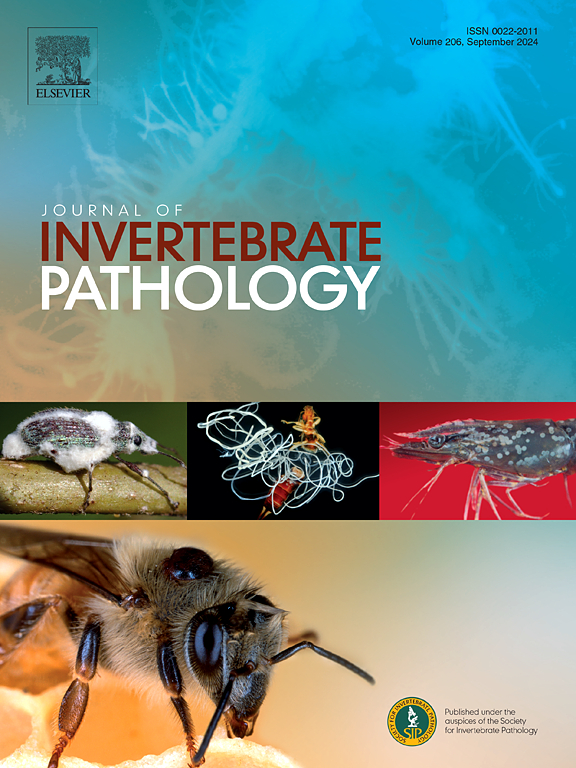Transcriptome analysis of Beauveria bassiana interaction with Nicotiana benthamiana reveals signatures of N. Benthamiana growth promotion and enhanced defense responses
IF 3.6
3区 生物学
Q1 ZOOLOGY
引用次数: 0
Abstract
Many entomopathogenic fungi form intimate (epi- and endo-phytic) associations with that plant that can stimulate plant growth and /or improve resistance to pathogens and insect pests. However, little is known concerning global gene networks that mediate such responses. Nicotiana benthamiana seedlings were artificially colonized by the entomogenous fungus, Beauveria bassiana, and the root tissues were examined via comparative transcriptome analyses performed versus fungal cells grown in vitro on dried root biomass. Plant hormone pathways, and genes involved in photosynthesis, immune defense response, and nutrient metabolism were triggered in roots after fungal colonization. Fungal differentially expressed genes during plant colonization included plant cell wall-degrading enzymes, and those involved in lipid metabolism, detoxification, and fungal cell wall remodeling, the latter suggesting reduction in the exposure of pathogen related molecular patterns to avoid perception by the plant immune system. Fungal metabolic genes involved in amino acid, nitrogen, sulfur and carbohydrate assimilation were activated, nutrient exchange with the plant host. Exchange was confirmed by detection of sulfur in the seedling that was increased by the fungal colonization. A set of fungal secondary metabolism-associated genes were also upregulated during the plant interaction, which might contribute to plant resistance against pathogens or/and insect pest. In addition, B. bassiana expressed a suite of effector/elicitor genes consistent with triggering plant growth and/or immune defense response pathways. These results revealed global gene networks active in both the plants and the fungus as a consequence of their symbiotic interaction, and provides insights into the molecular determinants and physiological responses affected.

球孢白僵菌与benthamiana相互作用的转录组分析揭示了benthamiana促进生长和增强防御反应的特征
许多昆虫病原真菌与植物形成密切的(外植和内植)联系,可以刺激植物生长和/或提高对病原体和害虫的抵抗力。然而,对介导这种反应的全球基因网络知之甚少。用虫生真菌白僵菌(Beauveria bassiana)人工定植本烟幼苗,并通过与体外培养的真菌细胞在干燥根生物量上的比较转录组分析来检测根组织。真菌定殖后,植物的激素通路以及参与光合作用、免疫防御反应和养分代谢的基因在根系中被触发。真菌在植物定植过程中的差异表达基因包括植物细胞壁降解酶,以及参与脂质代谢、解毒和真菌细胞壁重塑的基因,后者表明减少病原体相关分子模式的暴露,以避免被植物免疫系统感知。真菌参与氨基酸、氮、硫和碳水化合物同化的代谢基因被激活,与植物寄主进行养分交换。通过检测真菌定殖后增加的幼苗中的硫,证实了交换。在植物互作过程中,一组真菌次生代谢相关基因也被上调,这可能有助于植物抵抗病原体或/和害虫。此外,球孢白僵菌表达了一套与触发植物生长和/或免疫防御反应途径一致的效应/激发子基因。这些结果揭示了植物和真菌中活跃的全球基因网络,这是它们共生相互作用的结果,并提供了对受影响的分子决定因素和生理反应的见解。
本文章由计算机程序翻译,如有差异,请以英文原文为准。
求助全文
约1分钟内获得全文
求助全文
来源期刊
CiteScore
6.10
自引率
5.90%
发文量
94
审稿时长
1 months
期刊介绍:
The Journal of Invertebrate Pathology presents original research articles and notes on the induction and pathogenesis of diseases of invertebrates, including the suppression of diseases in beneficial species, and the use of diseases in controlling undesirable species. In addition, the journal publishes the results of physiological, morphological, genetic, immunological and ecological studies as related to the etiologic agents of diseases of invertebrates.
The Journal of Invertebrate Pathology is the adopted journal of the Society for Invertebrate Pathology, and is available to SIP members at a special reduced price.

 求助内容:
求助内容: 应助结果提醒方式:
应助结果提醒方式:


